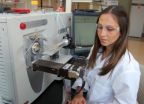(Press-News.org) New Rochelle, NY, January 10, 2013—Repeat traumatic brain injury affects a subgroup of the 3.5 million people who suffer head trauma each year. Even a mild repeat TBI that occurs when the brain is still recovering from an initial injury can result in poorer outcomes, especially in children and young adults. A metabolic marker that could serve as the basis for new mild TBI vulnerability guidelines is described in an article in Journal of Neurotrauma, a peer-reviewed journal from Mary Ann Liebert, Inc., publishers. The article is available free on the Journal of Neurotrauma website at http://www.liebertpub.com/neu.
In an Editorial, "The Window of Risk in Repeated Head Injury," accompanying this article, John T. Povlishock, PhD, Editor-in-Chief of Journal of Neurotrauma and Professor, VCU Neuroscience Center, Medical College of Virginia, Richmond, states that recent studies of TBI in animal models have shown that while repeat injury can exacerbate structural, functional, metabolic, and behavioral responses, "these responses only occur when the injury is repeated within a specific time frame post-injury."
"Specifically, this window of risk is greatest when the interval between injuries is short, hours to days, while any risk for increased damage is obviated when the intervals between injuries are elongated over days to weeks," says Dr. Povlishock. It is not yet clear if these time periods of increased risk are age- or gender-specific or depend on the intensity of the initial injury.
A consistent finding following TBI in both humans and animal models is a decrease in glucose uptake by the brain. Mayumi Prins, Daya Alexander, Christopher Giza, and David Hovda, The UCLA Brain Injury Research Center, Los Angeles, CA, simulated single and repeat (after 1 or 5 days) mild TBI in rats and measured cerebral glucose metabolism. They tested the hypothesis that the rats' brains would be more vulnerable to the damaging effects of repeat TBI at 1 day post-injury, when glucose metabolism was still decreased, than at 5 days, when it had returned to normal levels.
In the article, "Repeat Mild Traumatic Brain Injury: Mechanisms of Cerebral Vulnerability," the authors propose that the duration of metabolic slowdown in the brain could serve as a valuable biomarker for how long a child might be at increased risk of repeat TBI.
INFORMATION:
About the Journal
Journal of Neurotrauma is an authoritative peer-reviewed journal published 24 times per year in print and online that focuses on the latest advances in the clinical and laboratory investigation of traumatic brain and spinal cord injury. Emphasis is on the basic pathobiology of injury to the nervous system, and the papers and reviews evaluate preclinical and clinical trials targeted at improving the early management and long-term care and recovery of patients with traumatic brain injury. Journal of Neurotrauma is the Official Journal of the National Neurotrauma Society and the International Neurotrauma Society. Complete tables of content and a sample issue may be viewed on the Journal of Neurotrauma website at http://www.liebertpub.com/neu.
About the Publisher
Mary Ann Liebert, Inc., publishers is a privately held, fully integrated media company known for establishing authoritative medical and biomedical peer-reviewed journals, including Metabolic Syndrome and Related Disorders, Population Health Management, Diabetes Technology & Therapeutics, and Journal of Women's Health. Its biotechnology trade magazine, Genetic Engineering & Biotechnology News (GEN), was the first in its field and is today the industry's most widely read publication worldwide. A complete list of the firm's 70 journals, newsmagazines, and books is available on the Mary Ann Liebert, Inc., publishers website at http://www.liebertpub.com.
Mary Ann Liebert, Inc. 140 Huguenot Street, New Rochelle, NY 10801-5215 www.liebertpub.com
Phone (914) 740-2100 (800) M-LIEBERT Fax (914) 740-2101
Is there a period of increased vulnerability for repeat traumatic brain injury?
2013-01-10
ELSE PRESS RELEASES FROM THIS DATE:
New tool to help brain surgeons 1 step closer to operating room
2013-01-10
WEST LAFAYETTE, Ind. - A new tool that could allow for faster, more comprehensive testing of brain tissue during surgery successfully identified the cancer type, grade and tumor margins in five brain surgery patients, according to a Purdue University and Brigham and Women's Hospital study.
The tool sprays a microscopic stream of charged solvent onto the tissue surface to gather information about its molecular makeup and produces a color-coded image that reveals the nature and concentration of tumor cells.
Researchers analyzed specimens removed from the patients, but ...
Scientists design, control movements of molecular motor
2013-01-10
ATHENS, Ohio (Jan. 10, 2013)—An international team of scientists has taken the next step in creating nanoscale machines by designing a multi-component molecular motor that can be moved clockwise and counterclockwise.
Although researchers can rotate or switch individual molecules on and off, the new study is the first to create a stand-alone molecular motor that has multiple parts, said Saw-Wai Hla, an Ohio University professor of physics and astronomy who led the study with Christian Joachim of A*Star in Singapore and CEMES/CNRS in France and Gwenael Rapenne of CEMES/CNRS. ...
Giant tobacco plants that stay young forever
2013-01-10
The life of tobacco plants is short. They grow for around three to four months, followed by flowering and then die. Their size is also limited, with plants only growing to about one-and-a-half to two meters tall. Now, researchers at the Fraunhofer Institute for Molecular Biology and Applied Ecology IME in Münster have located the tobacco plant's very own fountain of youth, which means they can keep it forever young. The Münster-based researchers discovered a genetic switch which can prevent the plants from change blooming to flowering. This also averts the plants' early ...
Surgeons may use hand gestures to manipulate MRI images in OR
2013-01-10
WEST LAFAYETTE, Ind. — Doctors may soon be using a system in the operating room that recognizes hand gestures as commands to tell a computer to browse and display medical images of the patient during a surgery.
Surgeons routinely need to review medical images and records during surgery, but stepping away from the operating table and touching a keyboard and mouse can delay the procedure and increase the risk of spreading infection-causing bacteria, said Juan Pablo Wachs, an assistant professor of industrial engineering at Purdue University.
"One of the most ubiquitous ...
Which study strategies make the grade?
2013-01-10
Students everywhere, put down those highlighters and pick up some flashcards! Some of the most popular study strategies — such as highlighting and even rereading — don't show much promise for improving student learning, according to a new report published in Psychological Science in the Public Interest, a journal of the Association for Psychological Science.
In the report, John Dunlosky of Kent State University and a team of distinguished psychological scientists review the scientific evidence for ten learning techniques commonly used by students.
"Schools and parents ...
Cutting in and weaving irritate drivers the most, new CAMH study on road rage shows
2013-01-10
January 10, 2013 (Toronto) - Cutting in and weaving, speeding, and hostile displays are among the top online complaints posted by drivers, according to a new study by the Centre for Addiction and Mental Health (CAMH) recently published in an online issue of Accident Analysis and Prevention.
Driver aggression is a major safety concern and researchers estimate this behaviour is a factor in nearly half of all motor vehicle collisions. Identifying the underlying causes and strategies for preventing driver aggression continues to be a priority.
CAMH researcher Dr. Christine ...
High-frequency stock trading of little value to investors, general public
2013-01-10
The increase in the speed of stock trading from microseconds to nanoseconds leads to an increase in order cancellation, but little else of value to investors and the general public, says research by a University of Illinois business professor.
According to a forthcoming study by Mao Ye, a professor of finance at Illinois, the arms race in speed at the sub-millisecond level of stock trading is a "purely positional game" in which a trader's payoff depends on transaction speed relative to other traders.
"There are lots of extreme views about high-frequency trading, but ...
Decline in available liver transplants expected
2013-01-10
A new study, funded in part by the National Institutes of Health (NIH) and Health Resources and Services Administration, and published in the January 2013 issue of Liver Transplantation, a journal of the American Association for the Study of Liver Diseases (AASLD), found that the non-use of donor livers climbed through 2010 due to a worsening of donor liver quality, primarily from donation following cardiac death. Diabetes, donor age, and body mass index (BMI) were also linked to a decrease in use of organs.
"For patients with end-stage liver disease, transplantation ...
Lower nitrogen losses with perennial biofuel crops
2013-01-10
URBANA – Perennial biofuel crops such as miscanthus, whose high yields have led them to be considered an eventual alternative to corn in producing ethanol, are now shown to have another beneficial characteristic–the ability to reduce the escape of nitrogen in the environment. In a 4-year University of Illinois study that compared miscanthus, switchgrass, and mixed prairie species to typical corn-corn-soybean rotations, each of the perennial crops were highly efficient at reducing nitrogen losses, with miscanthus having the greatest yield.
"Our results clearly demonstrate ...
This week in Blood: Jan. 10, 2013
2013-01-10
Welcome to "This Week in Blood," a weekly snapshot of the hottest studies from each week's issue of Blood, the official journal of the American Society of Hematology (ASH), hand-picked by Blood Editor-in-Chief Bob Löwenberg, MD, and Deputy Editor Nancy Berliner, MD.
Systemic delivery of a TLR7 agonist in combination with radiation primes durable anti-tumor immune responses in mouse models of lymphoma, Dovedi et al.
This week's plenary paper offers a promising potential new immunotherapeutic modality for the treatment of lymphoma. The authors present convincing data ...






